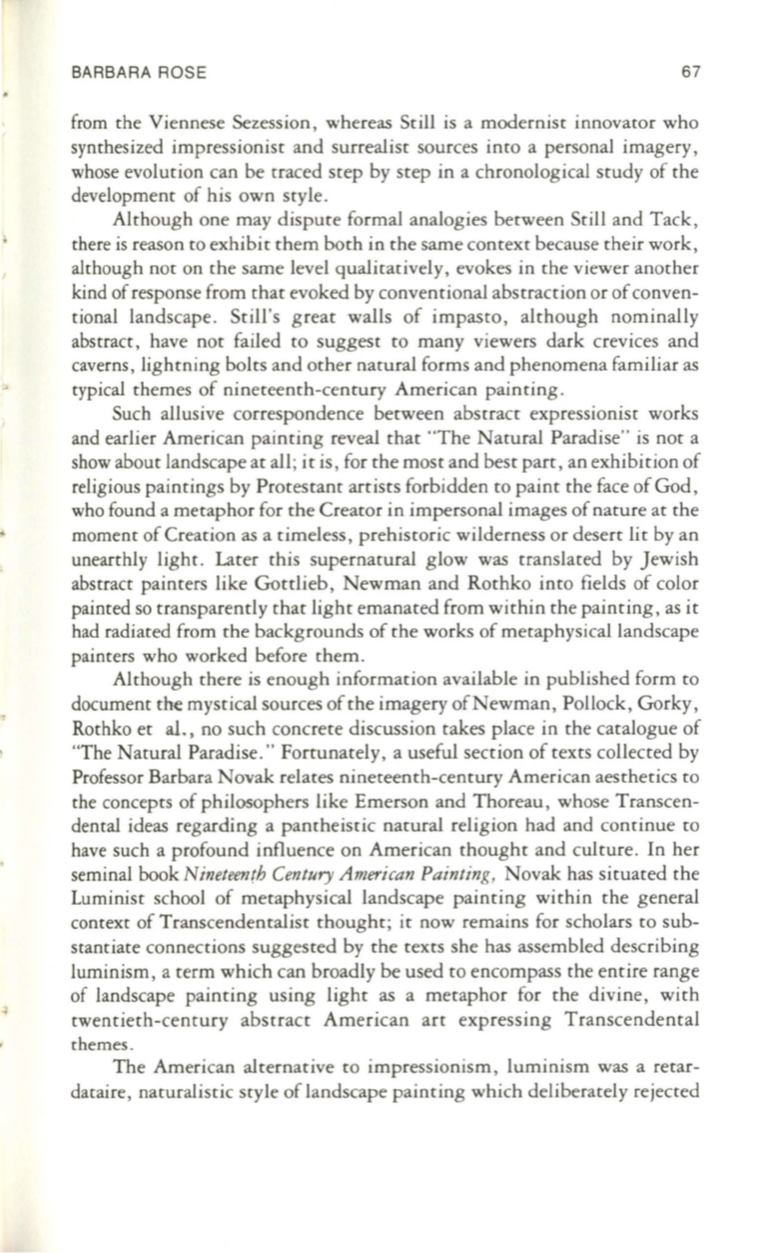
BARBARA ROSE
67
from the Viennese Sezession, whereas Still is a modernist innovator who
synthesized impressionist and surrealist sources into a personal imagery ,
whose evolution can be traced step by step in a chronolog ical study of the
development of his own style .
Although one may dispute formal analogies between Still and Tack ,
there is reason to exhibit them both in the same context because their work,
although not on the same level qualitatively, evokes in the viewer another
kind of response from that evoked by conventional abstraction or of conven–
tional landscape. Still's great walls of impasto, although nominally
abstract, have not failed to suggest to many viewers dark crevices and
caverns, lightning bolts and other natural forms and phenomena familiar as
typical themes of nineteenth-century American painting.
Such allusive correspondence between abstract expressionist works
and earlier American painting reveal that "The Natural Paradise" is not a
show about landscape at all; it is, for the most and best part, an exhibition of
religious paintings by Protestant artists forbidden to paint the face of God,
who found a metaphor for the Creator in impersonal images of nature at the
moment of Creation as a timeless, prehistoric wilderness or desert lit by an
unearthly light . Later this supernatural glow was translated by Jewish
abstract painters like Gottlieb, Newman and Rothko into fields of color
painted so transparently that light emanated from within the painting, as it
had radiated from the backgrounds of the works of metaphysical landscape
painters who worked before them .
Although there is enough information available in published form to
document the mystical sources of the imagery ofNewman , Pollock, Gorky ,
Rothko et
al. •
no such concrete discussion takes place in the catalogue of
"The Natural Paradise." Fortunately, a useful section of texts collected by
Professor Barbara Novak relates nineteenth-century American aesthetics to
the concepts of philosophers like Emerson and Thoreau , whose Transcen–
dental ideas regarding a pantheistic natural religion had and continue to
have such a profound influence on American thought and culture . In her
seminal book
Nineteenth Century American Painting,
Novak has situated the
Luminist school of metaphysical landscape painting within the general
context of Transcendentalist thought; it now remains for scholars to sub–
stantiate connections suggested by the texts she has assembled describing
luminism , a term which can broadly be used to encompass the entire range
of landscape painting using light as a metaphor for the divine, with
twentieth-century abstract American art expressing Transcendental
themes .
The American alternative to impressionism, luminism was a retar–
dataire, naturalistic style of landscape painting which deliberately rejected


